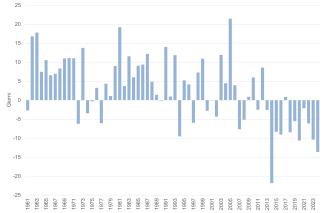Panel 1
Piero Fraschetti, Francesca Lena, Walter Perconti, Emanuela Piervitali, Giulio Settanta
This indicator describes trends in cold extremes across Italy, specifically quantifying the number of frost days, defined as days with daily minimum air temperature less than or equal to 0°C. In 2024, a reduction of approximately 13.7 frost days was observed compared to the 1991–2020 climatological baseline.
The presence of extreme temperature events and related long-term trends is assessed through the analysis of daily absolute minimum and maximum air temperatures. The indicator, based on definitions provided by the "CCL/CLIVAR Working Group on Climate Change Detection" refers to the number of days when the daily minimum air temperature is less than or equal to 0°C.
The annual time series of the average number of frost days, expressed as an anomaly relative to a climatological baseline, enables the estimation of the frequency of cold extremes and the identification of significant trends over time.
The indicator is not directly linked to any regulatory or legislative framework.
Panel 2
https://scia.isprambiente.it;
APAT-OMS, 2007, Cambiamenti climatici ed eventi estremi: rischi per la salute in Italia - Rapporti 77/2007
ISPRA, 2022, I normali climatici 1991-2020 di temperatura e precipitazione in Italia - Stato dell'Ambiente 99/2022
ISPRA, 2018, Variazioni della temperatura in Italia: estensione della base dati e aggiornamento della metodologia di calcolo – Stato dell’ambiente 81/2018;
ISPRA, 2016, Controlli di qualità delle serie di temperatura e precipitazione; Stato dell'Ambiente 66/2016
ISPRA, 2015, Valori climatici normali di temperatura e precipitazione in Italia; Stato dell'Ambiente 55/2015
ISPRA, 2014, Focus su "Le città e la sfida ai cambiamenti climatici"; Stato dell'Ambiente 54/2014
ISPRA, 2013, Variazioni e tendenze degli estremi di temperatura e precipitazione in Italia; Stato dell'Ambiente 37/2013
ISPRA, 2012, Elaborazione delle serie temporali per la stima delle tendenze climatiche; Stato dell'Ambiente 32/2012
Peterson T.C ., Folland C , Gruza G, Hogg W, Mokssit A e Plummer N., 2001, Report on the activities of the Working Group on Climate Change Detection and Related Rapporteurs 1998-2001. World Meteorological Organization, Rep. WC DMP-47, WMO -TD 1071, Geneva, Switzerland, 143 pp.;
SNPA, 2025, Il clima in Italia nel 2024; Report ambientali SNPA n. 44/2025
Toreti A. e Desiato F., 2007, Changes in temperature extremes over Italy in the last 44 years, Int. J. Climatology, DO I 10.1002/joc.1576.
Improvements in the estimation of frost days in Italy could result from the extension of the indicator calculation system to include additional sources of raw temperature data, with the aim of increasing the availability of long-term temperature time series that meet requirements of duration, continuity, and completeness.
Data quality assessment
ISPRA (Istituto Superiore per la Protezione e la Ricerca Ambientale)
SCIA – Sistema nazionale per l’elaborazione e diffusione di dati climatici (https://scia.isprambiente.it)
Italy
1961-2024
Indicator assessment
To determine if a specific day of the year can be defined as a day with frost, a comparison is made between the minimum temperature of that particular day and the threshold temperature of 0°C. Therefore, daily minimum temperature data is required. The program used by the SCIA system (National System for the Processing and Dissemination of Climatic Data) processes the raw data and returns a daily minimum temperature value, which is accepted as valid data only if it has passed certain checks. If the daily minimum temperature data is correct, the difference between this value and the 0°C threshold is calculated to determine if the day can be considered a day with frost. The annual value of the indicator is calculated by summing the number of days with frost in a given year. This value is accepted as valid data only if at least 75% of the valid daily data for the year in question is available. The climatological base for the calculation of anomalies has been updated to the most recent 30-year period, 1991-2020. This choice is based on recent recommendations from the World Meteorological Organization to update the climatological base every ten years for operational climatology purposes.
In 2024, a decrease of approximately 13.7 days with frost (average number of days with a minimum temperature less than or equal to 0°C) was observed compared to the average value calculated for the reference period 1991-2020. For the average number of frost days, 2024 ranks 2nd among the lowest of the entire historical series (Figure 1).
In the last 10 years, frost days have consistently been below the norm, except for 2017. Since the main international political strategies and programs concerning climate change aim to counteract the ongoing warming in the climate system, the assessment of an unfavorable trend and the assignment of the corresponding icon can be considered in terms of deviation from this objective.

Due to the mild winter temperatures, the frost days index (days with minimum temperature below 0 °C) recorded the second lowest value in the entire time series, after 2014, with a decrease of 13.7 days compared with the average for the 1991–2020 reference period (Figure 1).